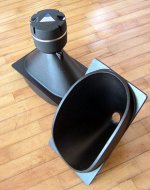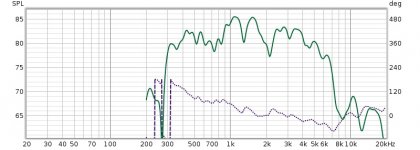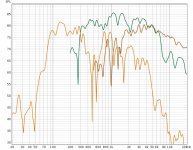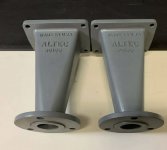It is alive! I did just a very quick listen, very low level and full range signal. I had it pointing up the ceiling - and the reflection from the ceiling was very even when moving around. Not sure what that means - maybe nothing, but I would expect some nice midrange sound at a distance. Once I have a free afternoon without the family at home, I will set it up with the rest of the system and make some measurements. Then I can take the risk and fill it with low expanding foam. Not sure if I ever make the second one, bit I am really happy with the result as the proof of concept for the construction was successful.
. . . . . a huge [stated] conical WG that until just recently realized it was actually parabolic since its top/bottom was parallel like a Smith horn.
Is this the sort of shape you're talking about?
Attachments
It doesn't appear to have any parallel sides, so no.
Like a Smith horn except no vanes and a much more rectangular aspect ratio with the same mouth dims as a 300 Hz Lansing/Altec 1803 multicell = 44" W x 24" H x 22" D with DIY throat adapter for dual 1" Altec CDs.
Like a Smith horn except no vanes and a much more rectangular aspect ratio with the same mouth dims as a 300 Hz Lansing/Altec 1803 multicell = 44" W x 24" H x 22" D with DIY throat adapter for dual 1" Altec CDs.
It is alive! I did just a very quick listen, very low level and full range signal. I had it pointing up the ceiling - and the reflection from the ceiling was very even when moving around. Not sure what that means - maybe nothing, but I would expect some nice midrange sound at a distance. Once I have a free afternoon without the family at home, I will set it up with the rest of the system and make some measurements. Then I can take the risk and fill it with low expanding foam. Not sure if I ever make the second one, bit I am really happy with the result as the proof of concept for the construction was successful.
Great! Keep us updated 🙂
It doesn't appear to have any parallel sides, so no. . . . . . . . .
Right, I get what you're saying now. Thanks.
(BTW, fyi the pic is of Bill Woods' Acoustic Horn Co conicals. AH-500.)
You're welcome!
Ah! We use to 'lock horns' over his lack of proper mouth end correction that I learned the hard way, though cheated and just made an open cell foam 'baffle' dense enough to sufficiently damp its eigenmodes without audibly over damping its mids/HF same as I was doing with all [now] vintage horns.
Ah! We use to 'lock horns' over his lack of proper mouth end correction that I learned the hard way, though cheated and just made an open cell foam 'baffle' dense enough to sufficiently damp its eigenmodes without audibly over damping its mids/HF same as I was doing with all [now] vintage horns.
Oh! Would you say a little more about which horns they were and how you made the foam 'baffle"? Do you still have/use them?
Thanks , again!
Thanks , again!
Just some quick measurement on axis of the middle cell in a small room. I would call this a success. This looks very good and I think this will be as good as any other multicell horn (well, except the looks🙂 )
Edit: It seems it would fit quite well with the small multicell and paraflex 1x12" C-2D.
Edit: It seems it would fit quite well with the small multicell and paraflex 1x12" C-2D.
Attachments
Last edited:
Congratulations! Nice that you're happy with the results. Not sure why you made that "except the looks" comment. I think they look really well done.
Well, wooden multicells, e.g. like the one from the OP or Markus Klug definitely look better. Not that mine would look too bad.
On the altec horns, it appears that the throat adapter is just a conical horn. Does anyone know how to make the calculation for this part?
For my printed horn, I calculated it with the same exponential expansion as the rest of the horn - or at least get close to that. Amd I used Hornresp to get the leght and profile shape for the guiding rails for lofting.
It's just a continuation of the flare frequency.
This is what I mean. The spreadsheet is a continuation of the exponential profile, but the altec just seems to be conical. This is the same angle as it exits the compression driver?
Attachments
Looking at the Altec single bore throat adapters they never appeared to me to be a true continuation of the horn flare. They seem to be just a quick was to get from the driver to the cells.
One should be able to do better. (If it matters)
One should be able to do better. (If it matters)
The flare frequency of the CD?
Correct, at least WRT every CD with an internal conical horn I've been exposed to and the horn flare frequency when there's none.
But I pretty much quit paying attention to what was available back in the mid '70s other than Altec and the late '90s DSL Unity/Synergy concept, which AFAIK are all conical [my horn of choice], so FWIW/YMMV. 😉
They seem to be just a quick was to get from the driver to the cells.
Depends, i.e for old spec cinema, PA, the HF cutoff was ~ 8-12.5 kHz at most, so yes a minimalist [flared] tube sufficed.
Yes, better in that the HF can be extended some and/or flattened more, but at least the Altec drivers weren't designed for the extra loading, so one winds up better off overall to just boost the extreme HF unless one needs > a watt or two at desired peak SPL.
Ok got it. Thank you!
What about the spacing between the cells, it looks to be about an 1” in the middle row and then just tapered to a triangle on the top and bottom rows. Is there any specific math for this or is it just aesthetic?
What about the spacing between the cells, it looks to be about an 1” in the middle row and then just tapered to a triangle on the top and bottom rows. Is there any specific math for this or is it just aesthetic?
- Home
- Loudspeakers
- Multi-Way
- The construction of a multicell horn




